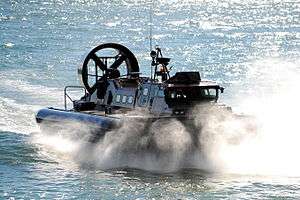
Griffon 2000TD hovercraft
The Griffon 2000 series is a light-weight hovercraft built in the United Kingdom by Griffon Hoverwork and used principally by military and rescue organisations.
Background
Griffon Hoverwork (GHL) of Hythe, England has designed, manufactured and operated hovercraft for over 40 years.
GHL was the first manufacturer to use turbo-diesel engines on hovercraft, which increases durability compared to conventional gasoline engines when exposed to salt water conditions. The company produces an extensive range of hovercraft, with payloads between 0.38 and 12 tonnes.
Configuration
The 2000 series was introduced in the early 1990s. The 2000TD series is slightly smaller than the older SR.N 6 hovercraft popular with commercial and military services during the 1970s, and has largely replaced the older SR.N6 series in most of these roles. Because it is constructed almost entirely out of aluminium the 2000TDX is less than half the weight of the older SR.N6 hovercraft.
The 2400TD was designed in 2008 due to the popularity of the 2000 series. It has greater obstacle clearance, is capable of carrying a higher payload and can reach higher speeds than the previous craft.
LCAC
LCAC may refer to:
Hovercraft
- Landing Craft Air Cushion, a US Navy hull classification symbol for the Landing Craft Air Cushion-class hovercraft
- LCAC(L), a light assault hovercraft used by the Royal Navy and Marines
- Lebed-class LCAC, an air-cushioned landing craft used by the Soviet and later Russian Navy
- Jingsah II-class LCAC, an air-cushioned landing craft used by the People's Liberation Army Navy
- Zubr-class LCAC, an air-cushioned landing craft used by the Russian, Hellenic, and People's Liberation Army Navies

LCAC (United Kingdom)
The Landing Craft Air Cushion (LCAC) in British service is a small amphibious hovercraft able to transverse both land and water. Like all amphibious landing craft in the Royal Navy, they are operated by the Royal Marines to transport troops or equipment from ship to shore during an amphibious landing.
2000TDX
The Griffon 2000TDX is the first LCAC(L) to enter service with the Royal Navy and Royal Marines, the added (L) indicates that it is a LCAC Light. The 2000TDX is based on the basic 2000TD model with modifications for military use. Due to the nature of the LCAC (being a hovercraft), they displace very little water despite their large size, they also produce next to no wake at high speed - this makes the LCAC more stealthy than traditional landing craft and with their powerful engines, much faster.
Four LCACs are in service as of 2012, with pennant numbers C21, C22, C23 and C24.
Specifications
The Landing Craft Air Cushion 2000TDX has the following specifications:

Ship-to-Shore Connector
The Ship-to-Shore Connector (SSC) is a system proposed by the US Navy as a replacement for the Landing Craft Air Cushion (LCAC). It will offer increased capacity, to cope with the growing weight of equipment used by the Army and Marines.As of 2015, the program is forecast to cost a total of US$4.054B for 73 hovercraft.
History
Several proposals have been made to replace the LCAC. In 2003, the Navy Transformation Roadmap set out plans to start R&D on a "Heavy Lift LCAC" project in 2005, but this was superseded by the LCAC(X) "LCAC Replacement Tactical Assault Connector". In August 2010, the US Navy issued a Request For Proposals for a contract to design and build 72 SSCs. The contract would be worth up to US$4 billion. A contract for detailed design work, and construction of the first test and training craft, was expected to be awarded in 2011.
Proposals
Podcasts:

